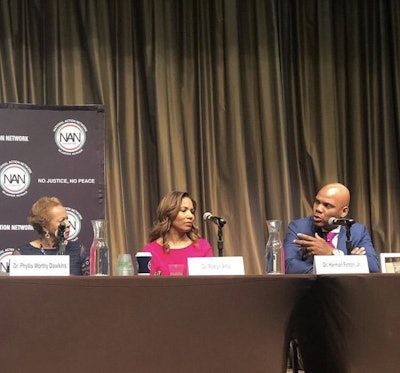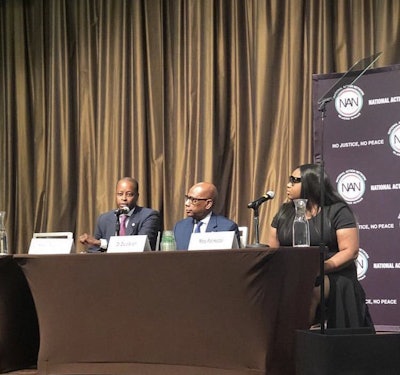NEW YORK-
Several presidents of historically Black colleges and universities (HBCUs) discussed the far-reaching influence of their institutions on American life during a panel held on Friday at the National Action Network (NAN) convention.
Statistics make an emphatic point. Over one-third of all African-Americans with degrees in STEM (science, technology, engineering and mathematics) fields earned their degrees at a HBCU. These are the institutions that produce Black electrical, civil and industrial engineers.
“This whole question about how critical these institutions are to our country is moot,” said Dr. David Wilson, president of Morgan State University in Baltimore. “I don’t think we as a nation can sit in any room and have a serious conversation about the long-term competitiveness of America if HBCUs are not at the epicenter of that conversation.”
Howard University president Dr. Wayne A. I. Frederick said he is living proof of the importance of HBCUs. He began his undergraduate studies at Howard as a 16-year-old with sickle cell anemia. He participated in the university’s BS/MD program, and completed medical school at the age of 22. Howard gave him an opportunity that other institutions would not.
“In 1978, there were more African-American males who applied to medical school than in 2014,” said Frederick. “If this continues over the next decade, seeing a Black male physician will be an anomaly. … Howard University sends more African-Americans to medical school than any other institution in the country.”
During the panel that was moderated by Diverse executive editor Dr. Jamal Watson, all of the presidents emphasized that HBCU institutions are inclusive, welcoming students of all backgrounds and ethnicities. Historically, these institutions have created warm, safe environments, said Dr. Roslyn Clark Artis, president of Benedict College in South Carolina.
Wilson, who has been at the helm of Morgan for the past nine years, said he did not see that attitude at the predominantly White institutions where he worked. 
“I felt it was important for me as an African-American woman to experience an institution and curriculum that I believe was specifically designed for me,” said panelist Mary-Pat Hector, a senior at Spelman College and national youth director of NAN. “It’s a place of sisterhood, love and care and a place that my professors care about me.”
Funding was a recurring point of discussion. Perhaps no one understands the issue better than Dr. Phyllis Worthy Dawkins, president of Bennett College, which is still enmeshed in a legal battle to keep its accreditation. “We produce in spite of the fact we are low resource,” said Dawkins.
“HBCUs are so important and we’re so under-resourced, particularly the independent private colleges,” said Dawkins. “Many of us need funds to ensure that our students graduate in four years without a financial struggle. The key to success in this society is education. We need our HBCUs to provide low income, first generation students’ opportunities to graduate.”
Artis said philanthropic support is crucial. HBCUs need active alumni and ambassadors. She encouraged attendees to share stories, write an op-ed and help spread the word about the importance of HBCUs.
“We need to be strong. We need to be effective. We need to produce at very high rates,” said Artis. “We need ambassadors. We need people who sing the praises of these institutions because they are worthy. Our stories are as yet untold.
“We need everyone to understand the work that is happening on these campuses,” she added. “We and generations prior have sent their children to other kinds of institutions because of the notion that we no longer need to patronize historically Black colleges and universities. … That’s just wrong. These schools are good schools and the productivity measures clearly bear that out.”
Dr. Herman Felton, Jr., president of Wiley College, said he is living proof of the importance and success of HBCUs. He did not graduate from high school. He grew up in poverty. He is dyslexic. He got into trouble. But when exposed to an undergraduate education at Edward Waters College, he was told he could become anything he wanted to be.
“The love, nurturing and support you get from one of those institutions can propel you to be the college president,” Felton said. “We have built and sustained the Black middle class and will continue to do those things, but if you do not understand that the playing field is not level and the playing field is money, then we will struggle—still doing great, but struggling.”
White philanthropists, such as the Rockefellers, Mellons and DuPonts have historically been supporters of HBCUs and institutions must tap today’s titans.
“We have to tap those 50 or 75 billionaires who have pledged to give away the majority of their wealth,” said Wilson. “Our institutions are open for your investment because with those investments we’re going to give the nation a significant return.”
All the presidents said educational leaders, alumni and supporters must continue to contact their federal and state legislators to see that there is sufficient funding for HBCUs and the creation of research centers at these institutions.
Frederick said gender equity must also be part of the conversation, noting that there are too few women HBCU presidents. When he became president of Howard, only one out of 15 senior deans was female. Today, there are 10. Seventy percent of current Howard undergrads are women.
“The Black male is in crisis,” said Frederick. “We have to make sure we support that Black male in every way, shape and form.”
Wilson noted that HBCU institutions must sustain their viability and vitality by being part of the transformation of higher education in America. There are currently 12 HBCUs that are Tier 2 research institutions. The goal, he said, should be that at least four of these become Tier 1, by 2028.
“We’re going to have to look at the program offerings on our campuses and ensure that we have some very unique, high demand programs that potential students will see the value in coming and enrolling in those programs,” said Wilson. “The skills that they get will enable them to be competitive with anyone, anywhere, anyplace, anytime,” he said adding that higher education is being challenged because in many areas there is a misalignment of academic degree programs with what industry needs.
“Programs like machine learning, artificial intelligence and data science. That is what industry and others are looking for.” he said. “With appropriate investments, we are the institutions that can produce a critical mass of diverse talent to enable these industries to diversity their work force in these unique, high demand areas.”















